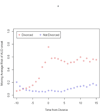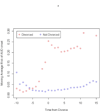Divorce and the Onset of Alcohol Use Disorder: A Swedish Population-Based Longitudinal Cohort and Co-Relative Study
- PMID: 28103713
- PMCID: PMC5411284
- DOI: 10.1176/appi.ajp.2016.16050589
Divorce and the Onset of Alcohol Use Disorder: A Swedish Population-Based Longitudinal Cohort and Co-Relative Study
Abstract
Objective: The purpose of this study was to clarify the magnitude and nature of the relationship between divorce and risk for alcohol use disorder (AUD).
Method: In a population-based Swedish sample of married individuals (N=942,366), the authors examined the association between divorce or widowhood and risk for first registration for AUD. AUD was assessed using medical, criminal, and pharmacy registries.
Results: Divorce was strongly associated with risk for first AUD onset in both men (hazard ratio=5.98, 95% CI=5.65-6.33) and women (hazard ratio=7.29, 95% CI=6.72-7.91). The hazard ratio was estimated for AUD onset given divorce among discordant monozygotic twins to equal 3.45 and 3.62 in men and women, respectively. Divorce was also associated with an AUD recurrence in those with AUD registrations before marriage. Furthermore, widowhood increased risk for AUD in men (hazard ratio=3.85, 95% CI=2.81-5.28) and women (hazard ratio=4.10, 95% CI=2.98-5.64). Among divorced individuals, remarriage was associated with a large decline in AUD in both sexes (men: hazard ratio=0.56, 95% CI=0.52-0.64; women: hazard ratio=0.61, 95% CI=0.55-0.69). Divorce produced a greater increase in first AUD onset in those with a family history of AUD or with prior externalizing behaviors.
Conclusions: Spousal loss through divorce or bereavement is associated with a large enduring increased AUD risk. This association likely reflects both causal and noncausal processes. That the AUD status of the spouse alters this association highlights the importance of spouse characteristics for the behavioral health consequences of spousal loss. The pronounced elevation in AUD risk following divorce or widowhood, and the protective effect of remarriage against subsequent AUD, speaks to the profound impact of marriage on problematic alcohol use.
Keywords: Alcohol Abuse; Epidemiology.
Conflict of interest statement
Disclosures
None of the authors have any conflicts of interest to declare.
Figures




Comment in
-
Swedish Register Analysis of Divorce and Alcohol Use Disorder Highlights Social Relationships as a Target for Preventive Psychiatry and Genetic Research.Am J Psychiatry. 2017 May 1;174(5):411-413. doi: 10.1176/appi.ajp.2017.17020170. Am J Psychiatry. 2017. PMID: 28457162 Free PMC article. No abstract available.
Similar articles
-
The Origin of Spousal Resemblance for Alcohol Use Disorder.JAMA Psychiatry. 2018 Mar 1;75(3):280-286. doi: 10.1001/jamapsychiatry.2017.4457. JAMA Psychiatry. 2018. PMID: 29417130 Free PMC article.
-
Effect of Marriage on Risk for Onset of Alcohol Use Disorder: A Longitudinal and Co-Relative Analysis in a Swedish National Sample.Am J Psychiatry. 2016 Sep 1;173(9):911-8. doi: 10.1176/appi.ajp.2016.15111373. Epub 2016 May 16. Am J Psychiatry. 2016. PMID: 27180900 Free PMC article.
-
Alcohol Use Disorder and Mortality Across the Lifespan: A Longitudinal Cohort and Co-relative Analysis.JAMA Psychiatry. 2016 Jun 1;73(6):575-81. doi: 10.1001/jamapsychiatry.2016.0360. JAMA Psychiatry. 2016. PMID: 27097014 Free PMC article.
-
Alcohol and the marriage effect.J Stud Alcohol Suppl. 1999 Mar;13:139-46. doi: 10.15288/jsas.1999.s13.139. J Stud Alcohol Suppl. 1999. PMID: 10225498 Review.
-
Marriage and risk of dementia: systematic review and meta-analysis of observational studies.J Neurol Neurosurg Psychiatry. 2018 Mar;89(3):231-238. doi: 10.1136/jnnp-2017-316274. Epub 2017 Nov 28. J Neurol Neurosurg Psychiatry. 2018. PMID: 29183957 Free PMC article.
Cited by
-
Military service and risk of subsequent drug use disorders among Swedish men.Soc Psychiatry Psychiatr Epidemiol. 2023 Jul;58(7):1039-1048. doi: 10.1007/s00127-023-02426-y. Epub 2023 Jan 21. Soc Psychiatry Psychiatr Epidemiol. 2023. PMID: 36680575 Free PMC article.
-
The impact of parenthood on risk of registration for alcohol use disorder in married individuals: a Swedish population-based analysis.Psychol Med. 2019 Oct;49(13):2141-2148. doi: 10.1017/S0033291718002969. Epub 2018 Oct 25. Psychol Med. 2019. PMID: 30355386 Free PMC article.
-
Prevalence and Correlates of Substance Use Among Youth Living with HIV in Fishing Communities in Uganda.AIDS Behav. 2024 Jul;28(7):2414-2426. doi: 10.1007/s10461-024-04339-6. Epub 2024 Apr 12. AIDS Behav. 2024. PMID: 38605252 Free PMC article.
-
Tobacco use in Haiti: findings from demographic and health survey.BMC Public Health. 2023 Dec 14;23(1):2504. doi: 10.1186/s12889-023-17409-6. BMC Public Health. 2023. PMID: 38097954 Free PMC article.
-
Swedish Register Analysis of Divorce and Alcohol Use Disorder Highlights Social Relationships as a Target for Preventive Psychiatry and Genetic Research.Am J Psychiatry. 2017 May 1;174(5):411-413. doi: 10.1176/appi.ajp.2017.17020170. Am J Psychiatry. 2017. PMID: 28457162 Free PMC article. No abstract available.
References
-
- Kessler RC, Walters EE, Forthofer MS. The social consequences of psychiatric disorders, III: probability of marital stability. Am J Psychiatry. 1998 Aug;155(8):1092–1096. - PubMed
-
- Power C, Rodgers B, Hope S. Heavy alcohol consumption and marital status: disentangling the relationship in a national study of young adults. Addiction. 1999 Oct;94(10):1477–1487. - PubMed
-
- Halme JT, Seppa K, Alho H, Pirkola S, Poikolainen K, Lonnqvist J, Aalto M. Hazardous drinking: prevalence and associations in the Finnish general population. Alcohol Clin Exp Res. 2008 Sep;32(9):1615–1622. - PubMed
Publication types
MeSH terms
Grants and funding
LinkOut - more resources
Full Text Sources
Other Literature Sources

